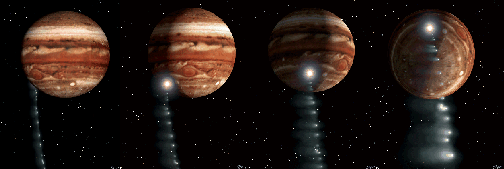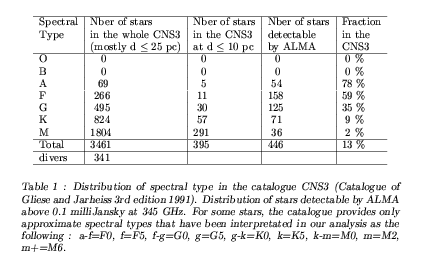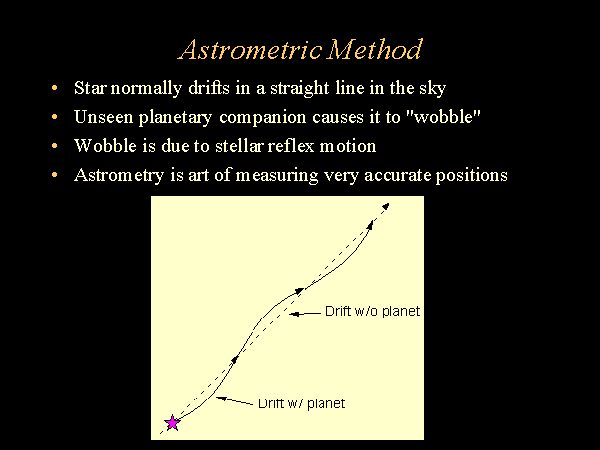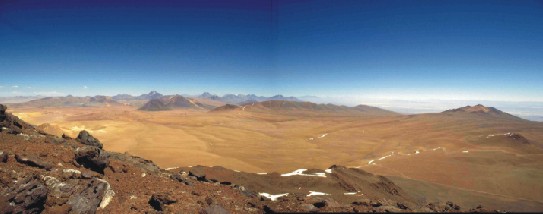
Perspective of discovering true analogs of Jupiter around nearby stars with ALMA
More than one hundred extra-solar planets were discovered since the first by Mayor and Queloz in 1995; they all are massive planets, similar to Jupiter (whose mass is approximately 300 times that of the Earth, and a thousandth of the Sun mass). Surprisingly, all have orbits very close to their stars, much nearer than Jupiter is from the Sun. This characteristic is due to the discovery method: by the velocity perturbation the planet imprints on its star. Indeed this velocity perturbation is the stronger as the planet is close to its star. A complementary method allows to discover more remote planets: astrometry. It consists in detecting the displacement of the star produced by the planet motion, which is in this case the larger as the planet is remote from its star. It would thus be possible to detect true analogs of Jupiter. Jean-François Lestrade, from Paris Observatory, proposes such an experiment, to be carried out with the future millimetre-wave interferometer ALMA.
The observation at Observatoire de Haute Provence of the first planet around another star of the solar type by Mayor and Queloz in 1995 was a resounding discovery. This planet of mass similar to Jupiter, instead of being far from its star as the architecture of our solar system had led the astromomers to think, was in fact very close to it, at approximately 1/10 of the Sun -- Mercury distance. All extra-solar planets -- orbiting around other stars than the Sun - discovered thereafter have the same property. They have masses similar to Jupiter but orbit radii smaller than that of Jupiter, i.e. 5 AU (1 Astronomical Unit = Sun-Earth distance).
However, Jupiter had an important role in the formation of the solar system. The large planetesimals (a few hundreds of kms in diameter) which did not succeed in accreting and forming planets after 100 million years were a threat for the already formed planets. In particular, the bombardment of the Earth by these bodies could have stopped or changed life evolution. In reality, the strong gravitational field of Jupiter trapped these remaining planetesimals by swallowing them or by deviating their trajectories far from the Sun to form the Oort cloud, currently surrounding the solar system at 50 000 AU. Jupiter cleaned the Solar system of a large part of these dangerous residues, thus protecting the Earth. The crushing of the Shoemaker-Levy comet on Jupiter in 1994 is the most recent and spectacular sweep by Jupiter in the Solar system (Figure 1).

|
Figure 1:
Montage (JPL) of the impact of the 21 pieces from the Shoemaker-Levy
comet on Jupiter from 16 to 21 july 1994 click inside the image to enlarge |
The search of the astronomers to improve our knowledge of extra-solar planets since 1995 is dominated by the extraordinary results obtained with the single radial velocity technique implemented by Mayor and other teams in the world. This technique measures the swing along the line of sight of the star orbiting the center of mass (centre of gravity) of its planetary system. This technique is sensitive to the velocity of this swing. For a given measuring accuracy, this technique is the more sensitive as the planet is massive and close to its star. With the current precision of a few metres/seconde, the majority of the exoplanets have masses similar to Jupiter or more and orbit radii lower than 2 AU, corresponding to orbital periods of less than 3 years. One realizes now that this result is biased by the sensitivity of the radial velocity technique to close-in exoplanets but that they had to be formed sufficiently far from their suns. Where the temperature is low enough that the ice core of these large gaseous planets can be formed. Afterwards, some approach their sun by a migration mechanism which is not completely elucidated and others, like Jupiter, remain on the orbit where they formed.
Astrometry has a key role in the search for these true analogs of Jupiter around other stars . Astrometry is an astronomical technique which allows to measure very precisely the motions of stars (Figure 2). In a similar way to the radial velocity technique, but in the plane of the sky, astrometry can detect the wobble of a star around the centre of mass of its planetary system. These oscillations are small and one needs an astrometrical accuracy of at least 100 micro arcsecond to undertake an interesting program on nearby stars, that is to say a precision 10 times better than that of the ESA astrometrical satellite Hipparcos. Astrometry, for a given precision, is sensitive to a planet of mass lower and lower as the duration of observations increases. Astrometry is thus complementary to the radial velocity technique(Figure 3).
| Figure 3:
ALMA Astrometry is complementary to the radial velocity technique (labeled Doppler and
RV on the figure),
as shown on this diagramm. Astrometry detects planets of mass lower
and lower as the duration of observation increases.
On the contrary, the radial velocity technique detects planets of mass
larger and larger as the duration of observation increases.
The two sensitivity lines cross at 12 yr for the ALMA precision of
100 micro arcsecond (0.1mas on the figure), and the precision
of radial velocity technique (RV) of 1m/s for the new program
HARPS at La Silla. Astrometry is thus more sensitive for observation duration larger
than 12yr. The search for exoplanets similar to Jupiter and Saturn
is the predilection domain of astrometry.
click inside the image to enlarge |

|
At Paris Observatory, Jean-François Lestrade proposes that the millimeter-wave array ALMA is used to search for these true analogs of Jupiter in a large sample of nearby stars. The ALMA interferometer (Figure 4) will have a good resolving power leading to an astrometrical precision of 100 micro arcsecond in theory. With this precision, ALMA will be sensitive to the planets of mass similar to Jupiter and orbital periods larger than 10 years. Long programms of astrometrical observations with ALMA thus open the very interesting prospect to discover true analogs of Jupiter around nearby stars (< 75 light-years).
>From the catalogue of Gliese and Jarheiss of 3802 nearby stars( stars less than 25 parsecs away, 1991 catalog), we calculated the radioelectric power received by ALMA from the thermal emission of the photosphere of each of the stars with spectral type. For this calculation, the temperature of photosphere, diameter of the stellar disc and distance of the star are required. Temperatures and diameters were determined from the star spectral type. We found that 446 stars are detectable by ALMA under good conditions for astrometry. The distribution of these stars according to their spectral types (O, B, A, F, G, K, M) is provided in Table 1. This astronomical classification orders stars according to the temperature of their photospheric surface, the O stars are the most massive and hottest (> 15 solar masses and 40 000 degrees), the M stars are the least massive and coldest (0.1 solar mass and 2400 degrees). The stars the most similar to the sun (G2) are of spectral types F, G and K and are well represented in table 1(CNS3= Catalog of Nearby Stars, 3rd edition).

|
ESA and NASA are developing each a space astrometrical project to search for exoplanets; named GAIA and SIM, respectively. Around 2010, these projects must result in the very high precision astrometry of 4 micro arcsecond (250 times better than Hipparcos in 1993). This extraordinary precision will allow to detect super-Earths of a few terrestrial masses with orbital periods of a few years only, necessarily shorter than the duration of the 5 years missions. Our project of observation on the ground with ALMA of less astrometrical precision (100 micro arcsecond) but authorizing longer durations of observation, higher than > 10 years, for the search of true analogs of Jupiters, is in fact complementary to GAIA and SIM.
Reference
Future Astrometry with ALMA to characterise extra-solar planet orbits Lestrade, J-F. , 2003, Proceedings of an International Conference on Scientific Frontiers in Research on Extrasolar PlanetsSymposium, held on June 18-21, 2002, in Washington DC, USA, ASP Conference Series, vol. 294, 2003, Editor Drake Deming and Seager, p. 587-590.
Contact:


 Jean-François Lestrade (Observatoire de Paris, LERMA)
Jean-François Lestrade (Observatoire de Paris, LERMA)


